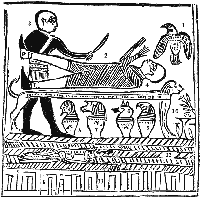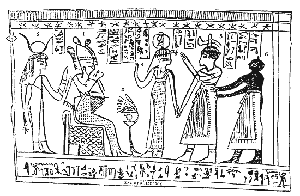Book of Abraham or Egyptian Book of Breathings?
Is the Mormon Book of Abraham a Hoax?
The Book of Mormon was said to have been translated from golden plates, which angels later took away, so the translation can no longer be checked against the originals.Joseph Smith translated the Book of Abraham from some scrolls he purchased from Michael Chandler in 1835. These scrolls disappeared for a time, and later "reappeared in the Metropolitan Museum of Art in New York City, which were clearly part of Joseph Smith’s original collection. The papyri were acquired by the Church, and they are now located at Brigham Young University." (quote from Michael D. Rhodes, “I Have a Question,” Ensign, July 1988, 51 - "Why doesn’t the translation of the Egyptian papyri found in 1967 match the text of the Book of Abraham in the Pearl of Great Price?" )
The papyri have been viewed and scholars' translations have shown them to be from the Egyptian Book of Breathings, an offshoot of the Egyptian Book of the Dead, not at all even related to Abraham.
According to Michael D. Rhodes, “I Have a Question,” Ensign, July 1988, 5, either "One explanation is that it may have been taken from a different portion of the papyrus rolls in Joseph Smith’s possession." or "A second explanation takes into consideration what Joseph Smith meant by the word translation. While translating the Book of Mormon, he used the Urim and Thummim rather than dictionaries and grammars of the language. Translating with the Urim and Thummim is evidently a much different process than using the tools of scholarly research."
Looking at the following graphics from the Book of Abraham and papyri, I do not think they speak of Abraham, and in fact the Book of Abraham cannot be from the papyri that contained these graphics. My personal opinion is that Joseph Smith received unrelated material from spirit channeling and did not actualy translate the papyri. Study and decide for yourself.
| Following are 3 graphics contained in the papyri and in the Book of Abraham (click to enlarge) | ||
|---|---|---|
 |  |  |
FairLDS.org discusses the issue in www.fairlds.org/apol/ai125.html
According to Hugh Nibley, “I Have a Question,” Ensign, Mar. 1976, 34:
Q: Are the three facsimiles related to each other?
A: Definitely, by all being attached to one and the same document, namely, the Joseph Smith Papyri X and XI, which contain a text of the Egyptian Book of Breathings.
The evidence shows Smith did not translate the papyri properly
I do not find any convincing arguments to show that Joseph Smith did translate the papyri correctly. It appears his translation is false, and has no relationship to the papyri.There is evidence that Joseph Smith used diviner's stones for Urim and Thummim, calling on spirits to do the work.
You can review some of the analyses that indicate that Joseph Smith's translation was false in the following:
Field Guide to Papyri,
www.carm.org/lds/ldspapyri.htm,
www.utlm.org/onlineresources/fallofbookabraham.htm and www.utlm.org/onlinebooks/changech11a.htm,
www.lds-mormon.com/book_of_abraham.shtml and www.lds-mormon.com/book_of_abraham.shtml,
|
Especially read www2.ida.net/graphics/shirtail/ponderin.htm (from www2.ida.net/graphics/shirtail/papyri.htm): |
|
"Debating the Book of Abraham with a Professional Egyptologist Dr. Castillos: http://www.geocities.com/martsego/comments.txt I've read the apologetic remarks by several Mormon writers trying to justify Joseph Smith's version of the figures in the three facsimiles attached to the Book of Abraham which I tried to consider with an open mind, but after some thought I found them to be quite unconvincing." |
Unfortunately, I must conclude that the "Book of Abraham" is not a correct translation of the papyri. This then puts into question the rest of the Joseph Smith translations. Were they translated from actual physical documents or were they spirit channeled?
Other questions I have on Mormonism are at lds.htm